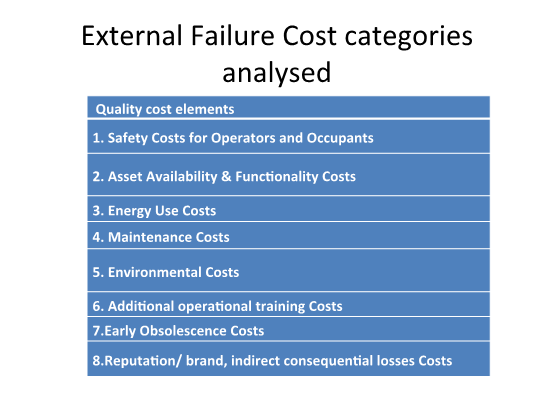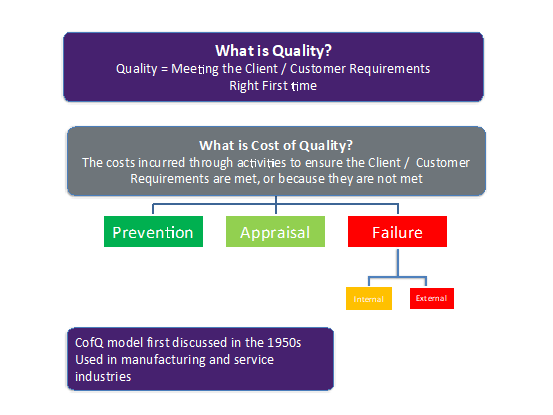This group was established around six years ago to examine the costs involved in ensuring the customer received the right product or, if not, the costs incurred due to failure to deliver the right product.
The Working Group has representatives from clients, contractors and academia.
Within construction, the issue is exceedingly complex with widely different sectors delivering widely different products both in terms of cost , complexity and consequences of failure. There are also projects delivered under agreements, different forms of contract and different forms of supply chain. The consequences of failing to deliver falls on various parties eg. client, designer, main contractor, subcontractor and supplier.
In order to get a basis for analysis we used a model as below:
We further discussed the areas in which we could obtain useful information which would add to the knowledge base. The cost of non-conformances was measured in many different ways and generally did not include consequential costs, This also did not include for field changes which could be substantial. The cost of defective work during construction has been addressed by the Get it Right Initiative. Our focus was therefore was to concentrate on post handover quality issues.
The Working Group is composed of volunteers who have day jobs and we realized that considerable effort was needed to produce results, In this basis we approached UCL for help. They initially conducted a desk study of publications worldwide which revealed that there is little information on this subject.
The exercise was to break down into subcategories as below:

This allowed us to look at projects across the world and assess the costs. This exercise was quite limited but gave us an insight into where the problems lie.
We then went onto study, in some detail, various projects interviewing staff who were involved in the project and its subsequent performance once delivered.
This lead to the following conclusions:
- Focus on quality during project delivery will not only improve the project during construction but will also deliver efficiencies in operations that are way better than the ones originally anticipated
- The performance of the project and its delivery strategy should not be based only on the time, cost and quality but also on the operational performance of the asset(s)
- Client, architect, designer, contractor, sub-contractor should work as a system. Because of the misalignment of their goals, the whole system is fragmented leading to operational failure
- In cases, procurement strategies, frameworks and contractual arrangements set by Clients lead to a fragmented construction industry where the different parts of the system have different goals and improvement of the system is almost impossible
- There was “blindness” of the senior leadership teams of both Clients and contractors around the operational impacts of the non-focus on quality
- Incentives for continuous improvement of the whole system are non-existent
- Contractors are sometimes set to fail because of early decisions. In cases, the Client choices early in the process can influence quality more than the contractor on site can ever influence
- Architects and designers feel no “pain” from quality issues, either on-site and more importantly in operations, as they are usually far removed from the project when it goes into delivery
- The delivery model plays an important role in the motivation of the supplier to solve errors as they happen in the project, to be open and honest about them, or hide them and leave them for later (they are somebody else’s problem anyway!)
- Procurement and contractual models sometimes contradict the culture for quality that the client wants to achieve. E.g. milestone payments, commercial incentives, retention money are creating incentives that are opposing the open and honest approach that continuous improvement requires.
- Learning from previous projects, errors and non-conformities, or defects is not used as a continuous improvement opportunity. In the cases where projects are learning from the past the benefit to the project is huge.
The group will now move on to look at other projects

